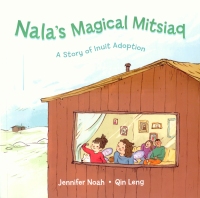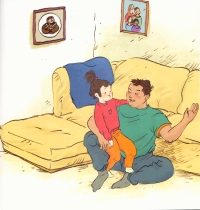| ________________
CM . . .
. Volume XX Number 21. . . .January 31, 2014 
 |
Nala’s Magical Mitsiaq: A Story of Inuit Adoption.
Jennifer Noah. Illustrated by Qin Leng.
Iqaluit, NU: Inhabit Media, 2013.
38 pp., pbk., $10.95.
ISBN 978-1-927095-26-3.
Kindergarten-grade 3 / Ages 5-8.
Review by Keith McPherson.
*** /4
|
| |
|

excerpt:
Qiatsuk grew in my belly,
while Nala grew in my heart,
sisters who arrived two years
and two months apart.
You are here with us now,
and forever we will be
a loving and devoted family.
Nala’s Magical Mitsiaq, an information book about Inuit custom adoption, is told through a question and answer conversation between two parents and their two very close primary-aged siblings. As the conversation unfolds, readers realize that one sibling is born into the family and one is adopted into the family through the unique process of Inuit custom adoption. The conversation continues to reveal how such adoptions may take place, how Inuit families and communities have been shaped by such loving relationships, and what the ‘magic’ or mitsiaq is behind such enduring and unique adoptions.
Children will have very little difficulty understanding the information in this book as much of it is presented through the siblings’ voices in a very straightforward question-and-answer format. Questions such as, “But why do I have a puukuluk [birth mother] and a birth family and Qiatsuk doesn’t?”, “I don’t understand why I didn’t grow in your belly like Qiatsuk did?” not only demonstrate the skilful manner in which the author, Jennifer Noah, captures a child’s voice, but also parallels the uncanny manner in which children so quickly get the heart of many family issues and discussions.
When read aloud, the story would be very understandable to young children. However, the text is fairly dense and sentences are often long and complex making this a grade 4 independent read.
 Qin Leng’s watercolour images bring the children’s home, town and snowy environment to wonderfully crisp and animated life. When readers are outside the siblings’ home, they can feel the ferociousness with which the blizzard blows across the pages, and when inside, they will feel like snuggling into the soft coats of the siblings’ warm pets and fluffy couches. Moreover, characters are not visually stereotyped, and facial expressions and loving gestures are natural, realistic and demonstrate deep affection between family and community members. The images fully support the text, and they very clearly complement the very natural and supportive roles that family members play in such adoptions.
Qin Leng’s watercolour images bring the children’s home, town and snowy environment to wonderfully crisp and animated life. When readers are outside the siblings’ home, they can feel the ferociousness with which the blizzard blows across the pages, and when inside, they will feel like snuggling into the soft coats of the siblings’ warm pets and fluffy couches. Moreover, characters are not visually stereotyped, and facial expressions and loving gestures are natural, realistic and demonstrate deep affection between family and community members. The images fully support the text, and they very clearly complement the very natural and supportive roles that family members play in such adoptions.
After the story, the author also provides an epilogue that explains her reasons for writing a story about Inuit custom adoption. She also provides more information into the important role custom adoption has, and still plays, in building Inuit families and shaping Inuit culture. I believe readers will find this segment very informative with such wonderful tidbits, including the fact that the Canadian government has recognized Inuit custom adoption since 1960.
The epilogue is also followed by two pages of quotes from Inuit women who have either been custom adopted, have custom adopted a child, or have given birth to a child who was custom adopted. These primary quotes add a strong layer of credibility and authority to the information in the text and help reinforce the book’s overall message that, when such adoptions are grounded in love and respect and honesty, the family and whole community will become much stronger.
Additionally, the author provides a glossary that is essential to readers unfamiliar with Inuit terms. I found myself regularly turning to the glossary to determine what was meant by key terms such as a kunik, aana and puukuluk.
Nala’s Magical Mitsiaq is an information book about custom Inuit adoption told largely through a fictional format. The story is informative, refreshing, engaging and supportive of relationships and families that are founded on honesty, respect and love. The children’s voices are realistic, making it strong read-aloud and thus providing access to content across multiple ages. This book would easily become a central component of any home or school library exploring adoption and Inuit culture (in general) and Inuit custom adoption (in specific).
Recommended.
Keith McPherson has been an elementary teacher and teacher-librarian in BC since 1984, and he is currently a program coordinator for the Faculty of Education at the University of British Columbia in Vancouver, BC.

To comment
on this title or this review, send mail to cm@umanitoba.ca.
Copyright © the Manitoba Library Association. Reproduction for personal
use is permitted only if this copyright notice is maintained. Any
other reproduction is prohibited without permission.
NEXT REVIEW |
TABLE OF CONTENTS FOR THIS ISSUE
- January 31, 2013.
AUTHORS |
TITLES |
MEDIA REVIEWS |
PROFILES |
BACK ISSUES |
SEARCH |
CMARCHIVE |
HOME |

 Qin Leng’s watercolour images bring the children’s home, town and snowy environment to wonderfully crisp and animated life. When readers are outside the siblings’ home, they can feel the ferociousness with which the blizzard blows across the pages, and when inside, they will feel like snuggling into the soft coats of the siblings’ warm pets and fluffy couches. Moreover, characters are not visually stereotyped, and facial expressions and loving gestures are natural, realistic and demonstrate deep affection between family and community members. The images fully support the text, and they very clearly complement the very natural and supportive roles that family members play in such adoptions.
Qin Leng’s watercolour images bring the children’s home, town and snowy environment to wonderfully crisp and animated life. When readers are outside the siblings’ home, they can feel the ferociousness with which the blizzard blows across the pages, and when inside, they will feel like snuggling into the soft coats of the siblings’ warm pets and fluffy couches. Moreover, characters are not visually stereotyped, and facial expressions and loving gestures are natural, realistic and demonstrate deep affection between family and community members. The images fully support the text, and they very clearly complement the very natural and supportive roles that family members play in such adoptions.